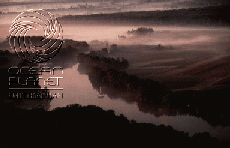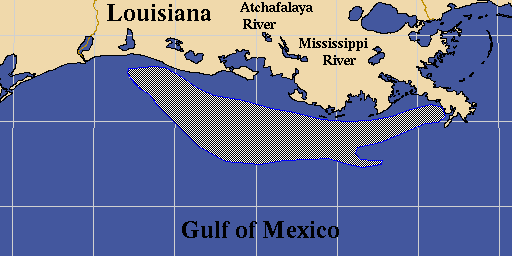The text on this site is presented as an
archival version of the script of "Ocean
Planet," a 1995 Smithsonian Institution
traveling exhibition. The content reflects the
state of knowledge at the time of the exhibition,
and has not been updated.

Side effects spread from land to sea
 Identifying a water polluter is a snap when you spot a single
pipeline spewing wastes. It's not so simple when you consider
that the line-up includes nearly everything we do on land.
It all contributes to nonpoint-source pollution--polluted runoff
that enters surface, ground water, and the oceans from widespread
and distant activities. It can lead to beach and shellfish-bed
closings, and spoiled habitats for fish and other aquatic life.
Identifying a water polluter is a snap when you spot a single
pipeline spewing wastes. It's not so simple when you consider
that the line-up includes nearly everything we do on land.
It all contributes to nonpoint-source pollution--polluted runoff
that enters surface, ground water, and the oceans from widespread
and distant activities. It can lead to beach and shellfish-bed
closings, and spoiled habitats for fish and other aquatic life.
Chesapeake Bay watershed, Maryland
photo © David H. Harvey/Woodfin Camp & Associates
- Agriculture and Livestock
Runoff from barnyards, feedlots, and cropland contributes
nutrients from manure and fertilizers, as well as pesticides and
eroded soil ¡.
- Urban Runoff
Urban runoff from buildings and paved surfaces carries sediment,
nutrients, bacteria, oil, trace metals, chemicals, road salt, pet
droppings, and litter §.
- Automobiles
Leaking oil and motor fluids run off roadways and into waterways.
Emissions send nitrogen and other contaminants into the
atmosphere, eventually to settle into coastal waters §.
- Land Clearing
Construction, clearing land, and logging often lead to soil
erosion, putting more sediment in rivers and coastal waters.
Filling in wetlands takes away vast natural water filters that
can break down many common pollutants before they reach other
water bodies.
- Sewage
Sewage, leached from faulty septic systems, or dumped directly
overboard instead of emptied at boat pumpout stations,
contributes nutrients and disease-causing organisms § §.
- Air Pollution
Airborne pollutants, chiefly from factories and automobiles, are
responsible for almost a third of all contaminants and nutrients
entering marine waters §.
- Industrial Waste
Industrial runoff brings heavy metals and other compounds into
marine waters, from industrial-waste landfills, from mining, and
from storm water draining off of industrial sites.

Warning Signs
Too many nutrients lead to too little oxygen
Too much nitrogen (from fertilizers, sewage, feedlot runoff, or
air pollution), or too much phosphorus (from the same sources, as
well as detergents or water-treatment chemicals), can set off
explosive growth of algae and aquatic plants. As the
overpopulated plants and algae die off, bacteria can deplete
oxygen from the water as they decompose the dead plants. Lack of
oxygen kills fish and other animals §.
 Pond after nutrient build-up
Pond after nutrient build-up
Chesapeake Bay Watershed, 1994
photo © David W. Harp
Gulf bottom-dwellers die in the "dead zone"
The Mississippi River drains nearly half of the continental U.S.,
carrying excess nutrients into the Gulf of Mexico §. During
the summer, decay of the resulting algal blooms consumes oxygen
and kills some animals and drives away others in a 4000-square-
mile bottom area (10,360 sq km) off the coast of Louisiana and
Texas §.

A "dead zone" occurs in the Gulf of Mexico each summer as
nutrient build-up leads to drastic reductions in oxygen in bottom
waters. Fish and shrimp catches virtually disappear § §.

First Aid
Iowa farmers reduce runoff pollution
In 1981 government agencies began farm-management and water-
quality monitoring programs in northeastern Iowa's Big Spring
Basin. Using fewer pesticides and fertilizers, and other good
farming practices such as crop rotation and contour planting, has
lowered nitrate levels in Big Spring Basin ground water. § §
 Analyzing barnyard manure for nutrient content allows farmers to use manure as an alternative to commercial fertilizers for corn, and to control nutrient-laden runoff from livestock operations.
Analyzing barnyard manure for nutrient content allows farmers to use manure as an alternative to commercial fertilizers for corn, and to control nutrient-laden runoff from livestock operations.
photo © Kathie Bentley, Northeast Iowa Demonstration Project
Managing hazardous waste hits home
Many products for home and garden can burn, explode, corrode, or
poison. Dumped down the drain, onto the ground, or into the
trash, they can pollute water, pose health risks, and damage
water-treatment systems. Since 1980, thousands of community
programs have begun to collect household hazardous waste. §
§
Get a handle on household hazards
To cut your "pollution contribution," use less hazardous or safe
products if you can. If you can't, use only as much as you need;
share leftovers with neighbors, businesses, or charities; and
dispose of leftovers safely.
The Chesapeake Bay depends on the kindness of many strangers
The Chesapeake Bay's watershed covers six states and the District
of Columbia, and drains 150 rivers and streams--an enormous
catch-all for urban, suburban, and agricultural pollution. A
landmark 1983 government agreement launched efforts to clean up
the bay § §. Successes include reducing nutrient pollution
from farming and livestock, bans on phosphate detergents and
tributyl-tin boat paints, and legal protection for
environmentally sensitive shorelines §.
 Storm-drain signs remind Baltimore neighbors that discards can harm the Chesapeake Bay.
Storm-drain signs remind Baltimore neighbors that discards can harm the Chesapeake Bay.
photo © David W. Harp, Chesapeake Bay Foundation
Other Resources:
 Ocean Planet Exhibition Floorplan
Ocean Planet Exhibition Floorplan

 gene carl feldman (gene@seawifs.gsfc.nasa.gov) (301) 286-9428
gene carl feldman (gene@seawifs.gsfc.nasa.gov) (301) 286-9428
Judith Gradwohl, Smithsonian Institution (Curator/Ocean Planet)
 Identifying a water polluter is a snap when you spot a single
pipeline spewing wastes. It's not so simple when you consider
that the line-up includes nearly everything we do on land.
It all contributes to nonpoint-source pollution--polluted runoff
that enters surface, ground water, and the oceans from widespread
and distant activities. It can lead to beach and shellfish-bed
closings, and spoiled habitats for fish and other aquatic life.
Identifying a water polluter is a snap when you spot a single
pipeline spewing wastes. It's not so simple when you consider
that the line-up includes nearly everything we do on land.
It all contributes to nonpoint-source pollution--polluted runoff
that enters surface, ground water, and the oceans from widespread
and distant activities. It can lead to beach and shellfish-bed
closings, and spoiled habitats for fish and other aquatic life.
![]()
 Pond after nutrient build-up
Pond after nutrient build-up
![]()
 Analyzing barnyard manure for nutrient content allows farmers to use manure as an alternative to commercial fertilizers for corn, and to control nutrient-laden runoff from livestock operations.
Analyzing barnyard manure for nutrient content allows farmers to use manure as an alternative to commercial fertilizers for corn, and to control nutrient-laden runoff from livestock operations.
 Storm-drain signs remind Baltimore neighbors that discards can harm the Chesapeake Bay.
Storm-drain signs remind Baltimore neighbors that discards can harm the Chesapeake Bay.
![]()